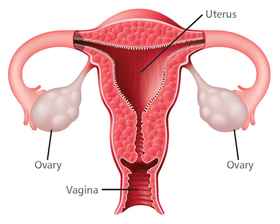The doctor may ask about personal and family medical history, and order one or more of the following tests.
Physical Examination
The doctor will may press on the abdomen to check for the potential tumours or abnormal build-up of fluid. A sample of the fluid may be taken for further investigation of the presence of ovarian cancer cells.
Pelvic Examination
The doctor feels the ovaries and nearby organs for any lumps or changes in their shape or size.
Blood Tests
The doctor may order blood tests for laboratory investigation of CA-125, a protein found on the surface of ovarian cancer cells and of other normal tissues. This test is approved by the Food and Drug Administration for monitoring an individual's response to ovarian cancer treatment and for any recurrence post-treatment. It is noteworthy that while high CA-125 levels may be indicative of ovarian cancer or other conditions, they are not definitive in the diagnosis of ovarian cancer.
Ultrasound
Ultrasound devices use sound waves to penetrate organs that are inside the pelvis. As sound waves bounce off organs, an attached computing system generates an image based on the resulting echoes. The image may reveal the presence of ovarian tumour. For better visualisation of the ovaries, the device may be inserted into the vagina, a procedure known as transvaginal ultrasound.
Biopsy
Biopsy is the removal of tissue or fluid for investigation of the presence of cancer cells. Based on the results of the blood tests and ultrasound, the doctor may recommend surgical intervention, such as a laparotomy, to remove tissue and fluid from the pelvis and abdomen. Surgery is usually needed to diagnose ovarian cancer.
Laparoscopy
A thin, lighted tube, known as a laparoscope, is inserted through a small incision in the abdomen. Laparoscopy may be used to remove small, benign cysts or early ovarian tumour. It may also be used to determine if the cancer has spread to other sites.


















